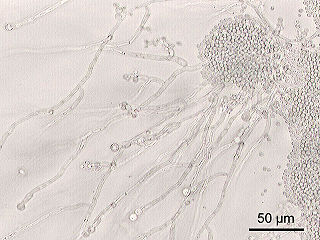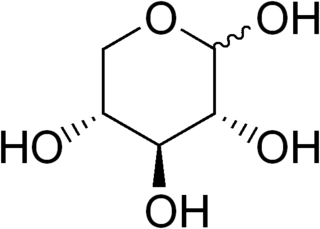
Yeasts are eukaryotic, single-celled microorganisms classified as members of the fungus kingdom. The first yeast originated hundreds of millions of years ago, and at least 1,500 species are currently recognized. They are estimated to constitute 1% of all described fungal species.

Saccharomyces cerevisiae is a species of yeast. The species has been instrumental in winemaking, baking, and brewing since ancient times. It is believed to have been originally isolated from the skin of grapes. It is one of the most intensively studied eukaryotic model organisms in molecular and cell biology, much like Escherichia coli as the model bacterium. It is the microorganism behind the most common type of fermentation. S. cerevisiae cells are round to ovoid, 5–10 μm in diameter. It reproduces by budding.

Cryptococcus is a genus of fungi in the family Cryptococcaceae that includes both yeasts and filamentous species. The filamentous, sexual forms or teleomorphs were formerly classified in the genus Filobasidiella, while Cryptococcus was reserved for the yeasts. Most yeast species formerly referred to Cryptococcus have now been placed in different genera. The name Cryptococcus comes from the Greek for "hidden sphere". Some Cryptococcus species cause a disease called cryptococcosis.

Candida is a genus of yeasts and is the most common cause of fungal infections worldwide. Many species are harmless commensals or endosymbionts of hosts including humans; however, when mucosal barriers are disrupted or the immune system is compromised they can invade and cause disease, known as an opportunistic infection. Candida is located on most mucosal surfaces and mainly the gastrointestinal tract, along with the skin. Candida albicans is the most commonly isolated species and can cause infections in humans and other animals. In winemaking, some species of Candida can potentially spoil wines.

Saccharomyces is a genus of fungi that includes many species of yeasts. Saccharomyces is from Greek σάκχαρον (sugar) and μύκης (fungus) and means sugar fungus. Many members of this genus are considered very important in food production. It is known as the brewer's yeast or baker's yeast. They are unicellular and saprotrophic fungi. One example is Saccharomyces cerevisiae, which is used in making bread, wine, and beer, and for human and animal health. Other members of this genus include the wild yeast Saccharomyces paradoxus that is the closest relative to S. cerevisiae, Saccharomyces bayanus, used in making wine, and Saccharomyces cerevisiaevar. boulardii, used in medicine.
Pichia pastoris is a species of methylotrophic yeast. It was found in the 1960s, with its feature of using methanol as a source of carbon and energy. After years of study, P. pastoris was widely used in biochemical research and biotech industries. With strong potential for being an expression system for protein production, as well as being a model organism for genetic study, P. pastoris has become important for biological research and biotech applications. In the last decade, some reports reassigned P. pastoris to the genus Komagataella with phylogenetic analysis, by genome sequencing of P. pastoris. The genus was split into K. phaffii, K. pastoris, and K. pseudopastoris.

A fungal prion is a prion that infects fungal hosts. Fungal prions are naturally occurring proteins that can switch between multiple, structurally distinct conformations, at least one of which is self-propagating and transmissible to other prions. This transmission of protein state represents an epigenetic phenomenon where information is encoded in the protein structure itself, instead of in nucleic acids. Several prion-forming proteins have been identified in fungi, primarily in the yeast Saccharomyces cerevisiae. These fungal prions are generally considered benign, and in some cases even confer a selectable advantage to the organism.

Torulaspora delbrueckii is a ubiquitous yeast species with both wild and anthropic habitats. The type strain of T. delbrueckii is CBS 1146T, equivalent to CLIB 230 or ATCC 10662, etc.. The type strain of T. delbrueckii CBS 1146 T was recently sequenced, and is composed of 8 chromosomes in addition to a mitochondrial genome.
Saccharomyces pastorianus is a yeast used industrially for the production of lager beer, and was named in honour of Louis Pasteur by the German Max Reess in 1870. This yeast's complicated genome appears to be the result of hybridisation between two pure species in the Saccharomyces species complex, a factor that led to difficulty in establishing a proper taxonomy of the species.
Saccharomyces bayanus is a yeast of the genus Saccharomyces, and is used in winemaking and cider fermentation, and to make distilled beverages. Saccharomyces bayanus, like Saccharomyces pastorianus, is now accepted to be the result of multiple hybridisation events between three pure species, Saccharomyces uvarum, Saccharomyces cerevisiae and Saccharomyces eubayanus. Notably, most commercial yeast cultures sold as pure S. bayanus for wine making, e.g. Lalvin EC-1118 strain, have been found to contain S. cerevisiae cultures instead

Ogataea polymorpha is a methylotrophic yeast with unusual characteristics. It is used as a protein factory for pharmaceuticals.

D-Xylose is a five-carbon aldose that can be catabolized or metabolized into useful products by a variety of organisms.
A killer yeast is a yeast, such as Saccharomyces cerevisiae, which is able to secrete one of a number of toxic proteins which are lethal to susceptible cells. These "killer toxins" are polypeptides that kill sensitive cells of the same or related species, often functioning by creating pores in target cell membranes. These yeast cells are immune to the toxic effects of the protein due to an intrinsic immunity. Killer yeast strains can be a problem in commercial processing because they can kill desirable strains. The killer yeast system was first described in 1963. Study of killer toxins helped to better understand the secretion pathway of yeast, which is similar to those of more complex eukaryotes. It also can be used in treatment of some diseases, mainly those caused by fungi.

Cider is an alcoholic beverage made from the fermented juice of apples. Cider is widely available in the United Kingdom and the Republic of Ireland. The UK has the world's highest per capita consumption, as well as the largest cider-producing companies. Ciders from the South West of England are generally stronger. Cider is also popular in many Commonwealth countries, such as India, Canada, Australia, and New Zealand. As well as the UK and its former colonies, cider is popular in Portugal, France, northern Italy, and northern Spain. Central Europe also has its own types of cider with Rhineland-Palatinate and Hesse producing a particularly tart version known as Apfelwein. In the U.S., varieties of fermented cider are often called hard cider to distinguish alcoholic cider from non-alcoholic apple cider or "sweet cider", also made from apples. In Canada, cider cannot contain less than 2.5% or over 13% absolute alcohol by volume.
Saccharomyces paradoxus is a wild yeast and the closest known species to the baker's yeast Saccharomyces cerevisiae. It is used in population genomics and phylogenetic studies to compare its wild characteristics to laboratory yeasts.
Saccharomyces eubayanus, a cryotolerant type of yeast, is most likely the parent of the lager brewing yeast, Saccharomyces pastorianus.

The role of yeast in winemaking is the most important element that distinguishes wine from grape juice. In the absence of oxygen, yeast converts the sugars of wine grapes into alcohol and carbon dioxide through the process of fermentation. The more sugars in the grapes, the higher the potential alcohol level of the wine if the yeast are allowed to carry out fermentation to dryness. Sometimes winemakers will stop fermentation early in order to leave some residual sugars and sweetness in the wine such as with dessert wines. This can be achieved by dropping fermentation temperatures to the point where the yeast are inactive, sterile filtering the wine to remove the yeast or fortification with brandy or neutral spirits to kill off the yeast cells. If fermentation is unintentionally stopped, such as when the yeasts become exhausted of available nutrients and the wine has not yet reached dryness, this is considered a stuck fermentation.
Aerobic fermentation or aerobic glycolysis is a metabolic process by which cells metabolize sugars via fermentation in the presence of oxygen and occurs through the repression of normal respiratory metabolism. It is referred to as the Crabtree effect in yeast. and is part of the Warburg effect in tumor cells. While aerobic fermentation does not produce adenosine triphosphate (ATP) in high yield, it allows proliferating cells to convert nutrients such as glucose and glutamine more efficiently into biomass by avoiding unnecessary catabolic oxidation of such nutrients into carbon dioxide, preserving carbon-carbon bonds and promoting anabolism.
Metschnikowia pulcherrima is a ubiquitous species of yeast, with numerous strains, belonging to the family Metschnikowiaceae, and found on grapes, cherries, flowers, spoiled fruit and consequently carried by fruit flies. It is a non-Saccharomyces yeast and plays an important role in the vinification of wine when it is present on grapes or winery equipment, and has historically seen use in South Africa’s wine industry. It is also being studied at the University of Bath as a possible alternative to the use of Palm oil, and early results show promise. M. pulcherrima is ovoid to ellipsoidal in shape and reproduces by budding. Its cells are globose and thick-walled, holding a single, large oil droplet of high refractive index. As the result of incomplete budding where cells remain attached after division, pseudohyphae may form under anaerobic conditions.
Lachancea thermotolerans is a species of yeast.









